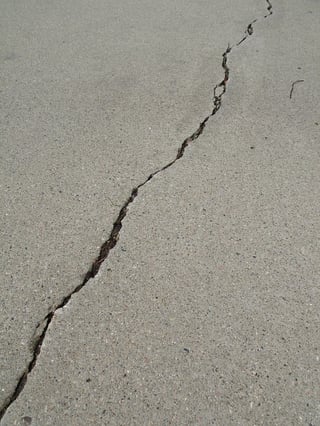 Have you ever walked into your company’s warehouse, manufacturing floor, or retail area to discover a large crack in your concrete floor that you're pretty sure wasn’t there the day before? Perhaps you’ve just had a brand-new concrete floor poured for your new facility, and a week later it’s covered in tiny cracks.
Have you ever walked into your company’s warehouse, manufacturing floor, or retail area to discover a large crack in your concrete floor that you're pretty sure wasn’t there the day before? Perhaps you’ve just had a brand-new concrete floor poured for your new facility, and a week later it’s covered in tiny cracks.
What happened? Is your floor weakened or damaged beyond repair?
Let’s take a look at some of the common reasons that concrete floors crack and what it means for your business:
Cracking is part of concrete’s natural tendency
When it’s first poured, concrete is a liquid. Over the course of a couple of days, it hardens into a solid, shrinking as it does so. This initial shrinking often results in hairline cracking within the first few days of installation. Different mixtures and ratios of the cement may minimize some cracking, but can’t eliminate it completely.
The chemical and physical reactions within the concrete don’t fully stop after it initially settles. Occasional cracking due to shrinkage can continue for decades—so the occasional crack isn’t anything out of the ordinary.
This kind of cracking is natural and inevitable and generally does not compromise the strength of the floor. Concrete has been a staple of construction since the time of the ancient Romans, thanks to its great compressive strength, and this aspect of its physics hasn’t stopped it from being the modern world’s building material of choice.
Cracking can also be caused by environmental changes
Concrete has very high compressive strength, but low tensile strength—that is, it stands up very well under heavy loads, but does not tolerate stretching or bending of any kind. If exposed to severe changes in temperature (as in a building without climate control) a concrete floor may crack as it expands.
It may also crack due to the freeze-thaw cycle during the winter, but this is more often a problem for outdoor sidewalks and patios that are directly exposed to the elements.
If you believe the climate may be playing a role in your floor’s cracking, consider getting a climate control system installed in your building.
Cracking may be due to foundation issues
A sudden increase in your concrete cracking may result from unusual pressures beneath the foundation. For example, after a heavy storm, some types of soil may swell with water and exert pressure upward against your concrete foundation, creating more tensile stress than it can handle.
In the same way, unstable soil can cause shifts beneath the slab (as is possible with a construction site that hasn’t been graded properly). Especially large and deep roots from nearby trees can also cause cracking, though this is more common in residential areas than industrial ones.
If you believe a sudden increase of cracking in your floor may be due to an issue with your foundation, you may need to get an expert on hand to make sure it’s not a warning sign of larger problems.
Problems caused by cracked floors
Again, in most cases, hairline cracks are harmless and don’t compromise the strength of the floor. Deeper cracks can cause a few other problems, however.
Since concrete is porous, some transfer of vapors from the ground into the building is inevitable (unless you have a vapor barrier coating). Deep cracks, however, can create a larger channel for gases such as water vapor or radon to enter, creating potential problems for workers.
Cracks can also become a place where moisture and spilled liquids can more easily seep in, causing staining or (if your facility deals with food or organic matter of any kind) can encourage the growth of bacteria within your floor.
Cracks that physically disrupt the surface of the floor can also cause issues. Not only can they create a tripping hazard for employees or customers, the exposed edges become more susceptible to spalling, especially if there are forklifts or other vehicles running over it regularly.
Cracks on the smooth surface of the floor become a gathering spot for dust and debris, making it harder to keep your floors sanitary.
Controlling issues with cracked concrete floors
The builder initially pouring your concrete have may carved straight “joints” into the floor, essentially creating a weaker spot that is more likely to crack. In this way, the cracks are more likely to fall along straight, planned lines.
Joints help with the aesthetics of the floor by preventing the appearance of random cracks. However, the cracks have many of the same problems as listed above, even if they do appear more orderly.
To prevent issues with leaks and spalling, you’ll want to have your joints and large cracks filled. If it’s a large gap, you can a rigid filler applied to mitigate the damage. For thinner cracks or joints, a soft sealer will smooth out the floor’s surface while still allowing the floor to expand and contract as needed. Learn more about joint and crack repairs.
If your main concern is with aesthetics (as in a retail environment), a skilled concrete floor contractor may be able to fill a crack to match it with the existing floor. The colors may never match exactly, however (since the age and exact concrete ratio may be different), so you may also want to consider dressing up your floor with concrete staining or a colorful floor coating.
Need an expert opinion?
Want to learn more about your options for dealing with concrete cracking? If you’re in the Southeastern U.S., one of our industrial flooring experts can take a look at your facility. Call us at (864) 855-0600, or contact us online for a free consultation.

